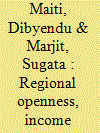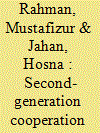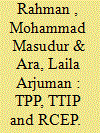|
|
|
Sort Order |
|
|
|
Items / Page
|
|
|
|
|
|
|
| Srl | Item |
| 1 |
ID:
139482


|
|
|
|
|
| Summary/Abstract |
The information technology (IT) sector has contributed significantly to the economic growth in India and is one of the fastest-growing export-oriented sectors in India. The objective of this article is to explore the determinants of exports of IT companies of India from 2000 to 2012 using company-level data. Applying ordinary panel data regression, the article finds that world demand and real effective exchange rate have expected signs on company exports. Surprisingly, foreign capital, which played a crucial role in IT sector development in India, has a negative coefficient, highlighting substitution relation between export and domestic demands. The dynamic panel data regression exhibits persistence of exports which acts as a moderating factor on demand fluctuations and its high impact. Further, the dynamic panel estimations clearly show the predominant influence of past exports on gross domestic product (GDP) growth in India, which makes world demand, standardized as relative to India’s GDP, inconsequential for its future exports.
|
|
|
|
|
|
|
|
|
|
|
|
|
|
|
|
| 2 |
ID:
139484


|
|
|
|
|
| Summary/Abstract |
This study analyzes the impact of spiralling growth in usage of contractual labour, in the context of stringent pro-worker labour regulations, on industrial labour productivity and employment generation. We obtain a quantitative measure of ‘stringency of labour regulations’ by applying majority rule on three different measures used in the literature. The results show that average labour productivity increases with the increase in the ratio of permanent workers to contractual workers, unless the industries are not operating in states having rigid/pro-worker labour regulations—which implies a negative impact of contractualization on labour productivity. Besides, the results show that the rigid/pro-worker labour regulations have negative impact on employment generation; it is especially discernible in labour-intensive industries.
|
|
|
|
|
|
|
|
|
|
|
|
|
|
|
|
| 3 |
ID:
139481


|
|
|
|
|
| Summary/Abstract |
In recent years, there has been an increase in multiple borrowing in the microfinance sector in Sri Lanka, while many microfinance institutions (MFIs) have experienced high levels of borrower turnover, deteriorating portfolio quality and weak financial performance. This has raised concerns about the microfinance sector. However, the debt levels for the majority of borrowers remain at moderate levels, while a number of mitigating factors such as mobilization of borrower savings by MFIs, wide use of pawning among clients and a reduction in donor funds to the sector suggest that a microcredit bubble in Sri Lanka is unlikely in the near future.
|
|
|
|
|
|
|
|
|
|
|
|
|
|
|
|
| 4 |
ID:
139485


|
|
|
|
|
| Summary/Abstract |
As a country progressively engages in international trade, its factors of production increasingly enter into the export sector, where their return is higher compared to the import-competing sector. At the regional level too, those states which can attune their production structure to international demands earn more from trade than other states, and also grow at a faster rate. A regional openness index has been reconstructed by combining the export and import intensities of the states, ranks of correlation of state production shares, respectively, with tradable production share as suitable weights at the state level. The index is highly influenced by the institutional variation across states in a federal setting. The per capita net state domestic products have been growing in all major states in India during the period 1980–2009, but at different rates, and one of the detrimental factors for this has been regional openness.
|
|
|
|
|
|
|
|
|
|
|
|
|
|
|
|
| 5 |
ID:
139483


|
|
|
|
|
| Summary/Abstract |
This study investigates the role of Bangladesh Small and Cottage Industries Corporation (BSCIC) in poverty reduction of Bangladesh. A total of 91 workers are surveyed who work in BSCIC estates and non-BSCIC manufacturing firms in the south-west region of Bangladesh. This study has used both panel and cross-section approaches. The study findings indicate that BSCIC has a significant role in industrial expansion and poverty reduction in Bangladesh. The regression results reveal that BSCIC significantly influences household consumption and poverty reduction. A 1 per cent increase in income from BSCIC will increase the yearly household consumption by 0.73 per cent, whereas it is only 0.36 per cent in case of non-BSCIC income. The impact of income increase on consumption is more than double for the BSCIC group households in comparison with non-BSCIC group households. In cross-section analysis, the purchasing power parity (PPP) at local currency of US$ 1.25 is considered in this study to construct poverty line. The result shows that, for an increase in the income from BSCIC by US$ 1 per month, income over poverty line increases (or the poverty gap decreases) by US$ 0.028 per month per household on average. Therefore, this study suggests for planned expansion of BSCIC for poverty reduction in Bangladesh.
|
|
|
|
|
|
|
|
|
|
|
|
|
|
|
|
| 6 |
ID:
139479


|
|
|
|
|
| Summary/Abstract |
South Asia remains one of the least integrated regions in the world, which is manifested in its lack of connectivity, low levels of intra-regional trade and weak investment flows. On the other hand, there is an apprehension that Southeast and East Asia could fall into a ‘middle income trap’, if they are not able to raise competitive strength and productivity further. In view of this, it is argued that there is a need for a framework of second-generation cooperation and integration embracing these three subregions in Southern Asia. This calls for concerted efforts to leverage existing institutional arrangements and put in place new avenues of subregional and inter-regional cooperation. Expansion of production networks, developments of value chains and greater integration of markets will allow these subregions to translate their respective comparative advantages into competitive advantages. Through harnessing opportunities of technology transfer, connectivity and greater factor mobility, and by taking advantage of cross-regional division of labour, these subregions could promote new patterns of inter-regional trade structure and specialization, which could benefit all the countries of Southern Asia.
|
|
|
|
|
|
|
|
|
|
|
|
|
|
|
|
| 7 |
ID:
139480


|
|
|
|
|
| Summary/Abstract |
The Transatlantic Trade and Investment Partnership (TTIP), the Trans-Pacific Partnership (TPP) and the Regional Comprehensive Economic Partnership (RCEP) could be the biggest trade deals in history. As the European Union (EU), the United States (US) and RCEP countries are the biggest trading partner of all South Asian countries, such preferential tariff arrangements could lead to a significant erosion of preferences enjoyed currently by the South Asian countries. Against this backdrop, the main objective of the present study is to investigate the potential economic impacts of tariff eliminations under TPP, TTIP and RCEP on South Asian countries using a standard computable general equilibrium model. The analysis evinces that under complete integration, in terms of tariff elimination, under these three mega deals, the excluded South Asian countries could face a tremendous negative impact on their economies. The analysis also suggests that South Asia may consider joining the TPP to minimize the negative economic impact due to arise from these mega deals.
|
|
|
|
|
|
|
|
|
|
|
|
|
|
|
|
|
|
|
|
|